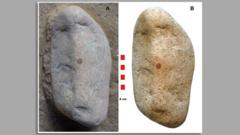A groundbreaking finding reveals that Neanderthals engaged in artistic expression, as demonstrated by the discovery of the oldest known human fingerprint on a pebble used for art roughly 43,000 years ago.
Neanderthal Artistry: The Discovery of an Ancient Fingerprint

Neanderthal Artistry: The Discovery of an Ancient Fingerprint
Scientists unearth evidence of Neanderthals creating art in Spain
Scientists in Spain have made a remarkable discovery that may change our understanding of Neanderthal capabilities, unveiling what they claim to be the oldest complete human fingerprint found to date. This intriguing find occurred at San Lázaro rock shelter in Segovia, where a rock resembling a human face was excavated, suggesting that Neanderthals practiced artistic techniques.
Research indicates that a Neanderthal dipped his finger in red ochre pigment to create a distinct nose on the pebble approximately 43,000 years ago. The strategic placement of this mark has led scientists to interpret it as a sign of symbolic thinking, indicating that Neanderthals possessed abstract thought. This new evidence adds a significant layer to the ongoing discussion surrounding the artistic powers of Neanderthals, as articulated by study co-author María de Andrés-Herrero following an interview with BBC’s Newsday.
The excavation process began five years ago, and in 2022, the team uncovered the distinctive stone positioned beneath 5 feet of sediment related to Neanderthal habitation. Initially, the researchers were astonished by the size of the pebble and the visible red dot that represented a human visage. Once ensured that the dot was composed of ochre, the team sought assistance from Spain's scientific police for extensive multi-spectrum analyses, ultimately revealing the fingerprint.
Despite identifying characteristics that suggest the fingerprint belonged to an adult male, study co-author David Álvarez Alonso noted the absence of comparative Neanderthal fingerprints challenges any definitive conclusions. Spanish official Gonzalo Santonja announced the stone as the oldest known painted portable object in Europe and the sole example of portable art attributed to Neanderthals.
Prof. de Andrés-Herrero emphasized that this discovery significantly contributes to discussions regarding Neanderthal symbolic behavior, marking the first recorded instance of a pigment-marked item in an archaeological setting. The context of the fingerprint further implies artistic intentions, as it was found in a non-utilitarian setting, implying that the dot’s creation was deliberate, rather than coincidental.
According to the researchers, the ochre pigment used in the creation of this dot was not locally sourced, reinforcing the idea that it was intentionally brought to the shelter. Their findings, published in the journal Archaeological and Anthropological Sciences, assert that this pebble embodies unique characteristics, qualifying it as a visual symbol that may be recognized as portable art in specific contexts.
Research indicates that a Neanderthal dipped his finger in red ochre pigment to create a distinct nose on the pebble approximately 43,000 years ago. The strategic placement of this mark has led scientists to interpret it as a sign of symbolic thinking, indicating that Neanderthals possessed abstract thought. This new evidence adds a significant layer to the ongoing discussion surrounding the artistic powers of Neanderthals, as articulated by study co-author María de Andrés-Herrero following an interview with BBC’s Newsday.
The excavation process began five years ago, and in 2022, the team uncovered the distinctive stone positioned beneath 5 feet of sediment related to Neanderthal habitation. Initially, the researchers were astonished by the size of the pebble and the visible red dot that represented a human visage. Once ensured that the dot was composed of ochre, the team sought assistance from Spain's scientific police for extensive multi-spectrum analyses, ultimately revealing the fingerprint.
Despite identifying characteristics that suggest the fingerprint belonged to an adult male, study co-author David Álvarez Alonso noted the absence of comparative Neanderthal fingerprints challenges any definitive conclusions. Spanish official Gonzalo Santonja announced the stone as the oldest known painted portable object in Europe and the sole example of portable art attributed to Neanderthals.
Prof. de Andrés-Herrero emphasized that this discovery significantly contributes to discussions regarding Neanderthal symbolic behavior, marking the first recorded instance of a pigment-marked item in an archaeological setting. The context of the fingerprint further implies artistic intentions, as it was found in a non-utilitarian setting, implying that the dot’s creation was deliberate, rather than coincidental.
According to the researchers, the ochre pigment used in the creation of this dot was not locally sourced, reinforcing the idea that it was intentionally brought to the shelter. Their findings, published in the journal Archaeological and Anthropological Sciences, assert that this pebble embodies unique characteristics, qualifying it as a visual symbol that may be recognized as portable art in specific contexts.





















